
Beef broth is a relatively common ingredient that adds a flavor punch to any meal. Whether as a base for a stew or part of a marinade for a beef dish, beef broth is an important part of any recipe. Whether you find yourself without or you are looking for ways to make your dish gluten-free, vegetarian or vegan, we have several great alternatives for you.
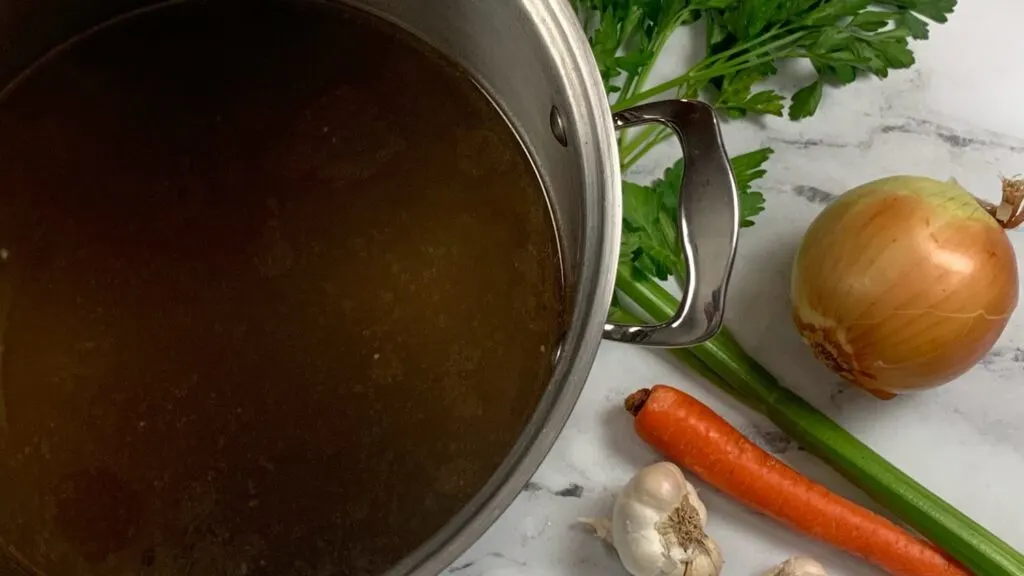
Table of Contents
What is Beef Broth?
Beef broth is made by combining beef, often on the bones but can be by itself, with carrots, celery, onions (often referred to as mirepoix), and aromatics (including bay leaves, peppercorns, garlic and parsley) and simmering them in boiling water for several hours. There are several different nuiances and varieties in the way people prepare beef broth. For example, many people roast the beef bones and vegetables prior to adding to the water and aromatics. Some, add tomato paste to add a deeper color and flavor. Others like to add vinegar to enhance the flavor. While others do all of the above.
Regardless of your preferred recipe, people like beef broth because of it’s rich beefy flavor.
Is Beef Broth Gluten-Free?
In most cases yes. Many store bought brands beef stock are gluten-free but not all. I would be sure to check the labels. If you make your own beef broth, all of the ingredients are naturally gluten-free so you shouldn’t run into an issue.
How is Beef Broth Used?
Commonly used as a base for soups and stews, beef broth is also used in sauces, pot roasts, and beef dishes. It is a versatile and important component to many dishes that should never be left out of a dish without being substituted with something else that will provide the flavors required by the recipe.
Substitutes for Beef Broth
1. Beef Stock, Beef Consommé, Beef Bone Broth, Beef base

I listed all of these in one because I feel this is kind of a cheat answer given they are made of essentially the same ingredients as beef broth. However, each has their own unique differences and those are important to know so I’ll start by giving a quick definition of each.
What is Beef Stock?
Beef is made of the same ingredients as beef broth but uses cleaned bones that contain no meat where beef broth uses bones containing meat or just meat by itself. Beef stock combines cleaned beef bones with mirepoix vegetables and aromatics and simmers them in boiling water for several hours. Like beef broth, the bones and vegetables are often roasted before being added to the water and combined with the aromatics. Tomato paste and other ingredients are often added to add to the flavor or color of the stock.
Since beef stock uses cleaned bones where broth uses the beef meat (whether on the bone or by itself), beef broth tends to be a bit fattier than beef stock. Also, beef broth sometimes contains more seasoning than stock, depending on the recipe used.
What is Beef Consommé?
Beef consommé is beef stock that has been clarified, meaning all the particles removed, and reduced, meaning the excess water is simmered out, thickening the consommé and intensifying the flavor.
Consommé has a clear brown color and has a more intense flavor due to the reduction process. Consommé is also served as a soup by itself whereas beef broth and beef stock are more likely used as one of several ingredients in a dish.
What is Beef Bone Broth?
Like beef stock, bone broth uses cleaned bones that do not contain meat and simmers them with mirepoix vegetables and aromatics, often roasting the bones and vegetables before. Bones with lots of connective tissue, such as knuckle bones, work best due to their high concentration of collagen.
While beef bone broth and beef stock have very similar ingredients and preparation techniques, there are some key differences. First is cooking time; bone broth is simmered much longer than stock ranging from 12 to 48 hours. Second, bone broth is often intended as a healthy drink and often times has a saltier flavor than stock. Finally, bone broth tends to use bones with lots of connective tissues where beef stock does not.
Health benefits including weight management, better hydration, improved sleep and overall improved nutrition have made bone broth popular as of late.
What is Beef Base?
Beef base is beef stock that has been reduced two to three times, giving it a thicker consistency, darker color and more intense flavor. Unlike beef consommé, beef base has not been clarified and has a syrup-like consistency a more cloudy appearance. Also unlike beef consommé, beef base is typically used as an ingredient that requires strong beef flavor but less liquid than beef broth or beef stock.
How to Substitute for Beef Broth
Because of the similar ingredients and preparation methods, all of the options listed above would be the best substitutes to get you the flavor you are needing from beef broth. Knowing the differences between the above options is helpful in understanding whether you need to add any other ingredients to compensate for the differences.
Beef stock and bone broth can be substituted using a 1:1 ratio with beef broth as they have similar flavors and intensities.
As beef consommé and beef base are reductions, I would start by mixing one cup of water for each cup of base or consommé prior using as a substitute. I would then taste to make it tastes right, adjusting the mixture as necessary. Once you are happy with the diluted result, you can substitute using a 1:1 ratio.
All of the alternatives above are naturally gluten-free but be sure to check your labels as some brands add wheat in some of the spices and flavorings used. As these all contain beef, they would not be a good vegetarian or vegan option.
2. Beef Bouillon Cubes

Like the option above, listing beef bouillon as a substitute for beef broth may be cheating a little bit because bouillon is broth that has been dehydrated and formed into solid cubes. Once dissolved into hot water, you essentially have beef broth.
This makes beef bouillon a great substitute for beef broth. In fact, because it is smaller and has a shelf life of 18 to 24 months after being opened, it is definitely a convenient alternative.
One bouillon cube dissolved into one cup of boiling water can be substituted for one cup of beef broth.
Beef stock concentrate, such as Better than Bouillon, would also work just as well.
There are gluten-free bouillon cubes but you have to make sure to check the labels as some brands do contain wheat. This is also not a good vegetarian or vegan option as beef is an ingredient.
3. Worcestershire Sauce

Worcestershire sauce is a great way to add rich flavors similar to those found in beef broth. It is a fermented sauce that is made with vinegar, anchovies, tamarind, garlic, molasses and other seasonings. This unique combination offers a complex flavor found in few other ingredients.
To substitute, I would mix one tablespoon to a cup of water or, if you have it, vegetable, mushroom, or chicken broth. You can then substitute this mix on a 1:1 ratio with beef broth.
Make sure to check the labels if you are gluten intolerant as several brands are gluten-free, but some are not. This is not a vegan or vegetarian option since it contains fish.
4. Soy Sauce and Steak Sauce Combined
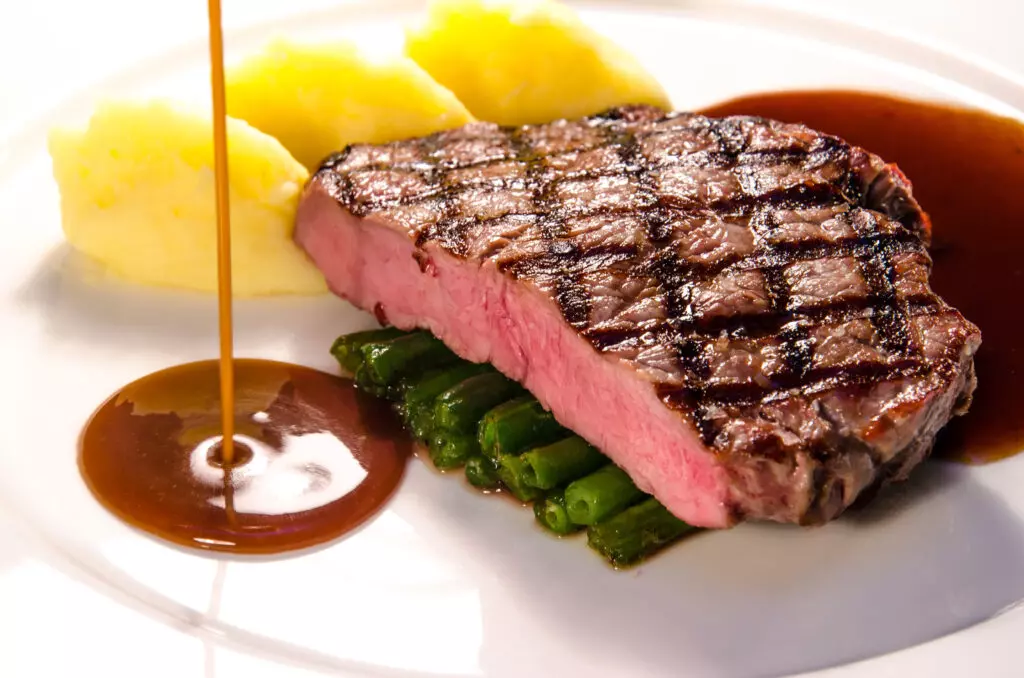
The combination of flavors and salt in soy sauce and steak sauce makes for a great beef broth substitute. The saltiness of the soy sauce combined with the rich and bold flavors of the steak sauce pack a powerful flavor punch.
I would mix equal parts soy sauce to steak sauce. I would then add one tablespoon of the mixed contents to 1 cup of water to start and add more to taste. Once you like the flavor of the mixture you can substitute on a 1:1 ratio.
Most soy sauces and steak sauces contain gluten, but gluten-free versions can be purchased. Most steak sauces and soy sauces are vegan and vegetarian friendly but again, check your labels as some use meat flavorings.
5. Red Wine

levgenii Meyer / Shutterstock
Wine, especially a full-bodied red, has a flavor that naturally complements beef. Think of how much better your steak tastes when enjoyed with a glass of your favorite wine. Think of how wine brings out the savory flavors in dishes like beef bourguignon. I love the flavor in red wine reduction sauces in beef dishes.
Wine brings a rich flavor and a dark color to your stock. You can substitute one cup of wine for one cup of beef broth.
Wine is a naturally gluten-free option and is also a great vegetarian and vegan alternative.
6. Mushroom Broth

Anna Hoychuk / Shutterstock
Mushroom broth is made by simmering mushrooms, onions and aromatics in water, giving it a rich and earthy flavor. This alternative has similar flavors to beef broth and serves as a great substitute for beef broth. However, you can enhance the flavor further by adding a little Worcestershire sauce or soy sauce to the broth.
This is a vegetarian and vegan friendly option. In most cases mushroom broth will be gluten free but be sure to check your labels to make sure.
7. Soy Sauce
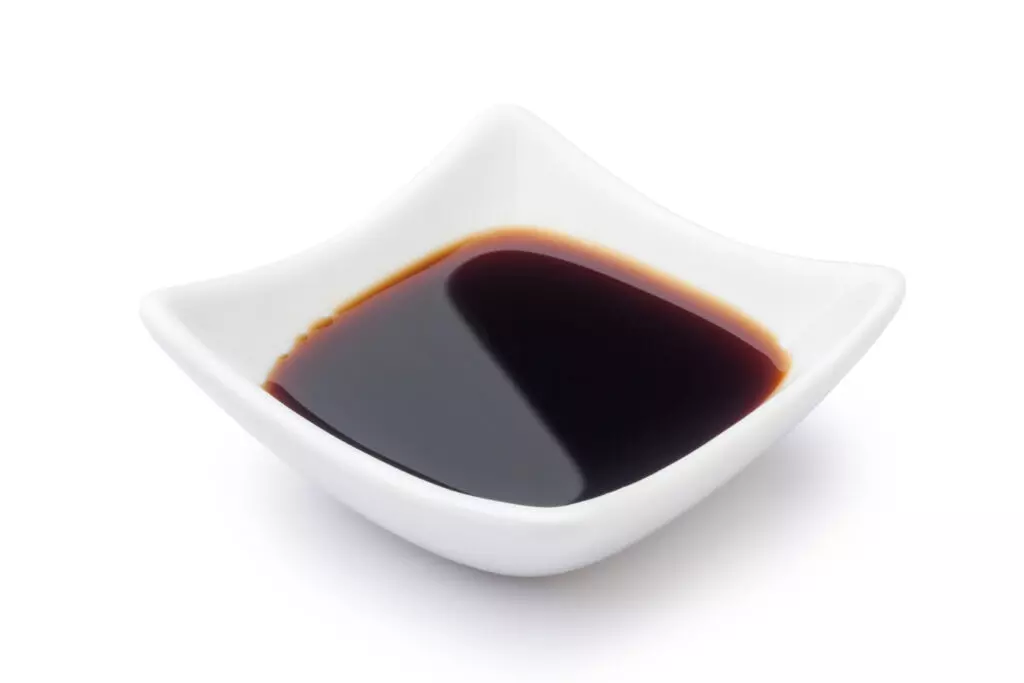
Soy sauce has a savory and salty flavor that works great as a substitute for beef broth.
Like Worcestershire sauce, I would mix one tablespoon of soy sauce with one cup of water or another substitute broth, and then substitute the mix on a 1:1 ratio with beef broth.
As mentioned above, this is a vegan friendly option but often contains gluten unless you purchase a gluten-free version of soy sauce.
8. Miso Paste
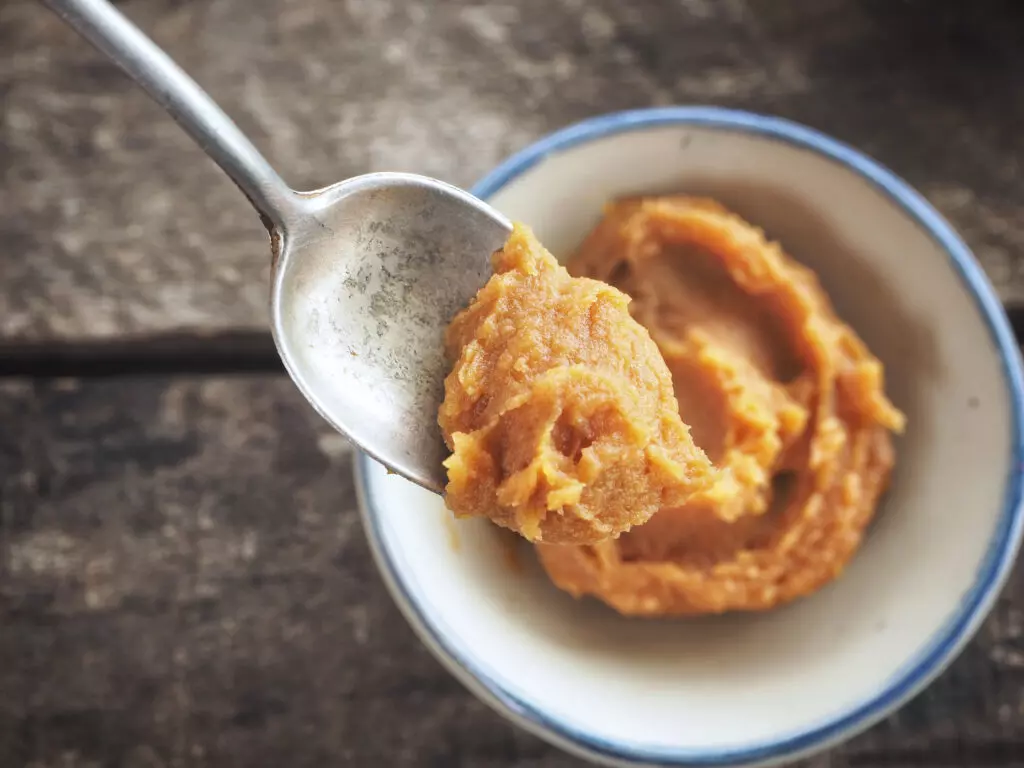
Miso paste is a fermented combination of soybeans, grains and a mold called koji. Commonly used in miso soup, miso paste provides a rich and slightly salty flavor that works great as a substitute for beef broth.
Popular in Japan, miso paste comes in a variety of tastes and colors, depending on the region it is made. The red or yellow miso pastes work best as a substitute as those flavors best match beef broth.
I would start by combining one tablespoon of miso paste with one cup of water and adding more to taste. Once you are happy with the combined flavor, you can substitute on a 1:1 ratio.
9. Vegetable Broth

Vegetable broth is made by combining the same ingredients as beef broth, excluding the beef, and simmering in water. As you are not breaking down the bones or meat, the simmering time is considerably less for vegetable stock, requiring only around 45 minutes.
Like mushroom broth, I would add a little Worcestershire sauce or soy sauce to compensate for the rich flavors of the missing beef. However, depending on the dish, that may not be needed.
In most cases this will be good gluten-free option but be sure to check your labels. Vegetable broth is a vegetarian and vegan friendly alternative to beef broth.
10. Chicken Broth
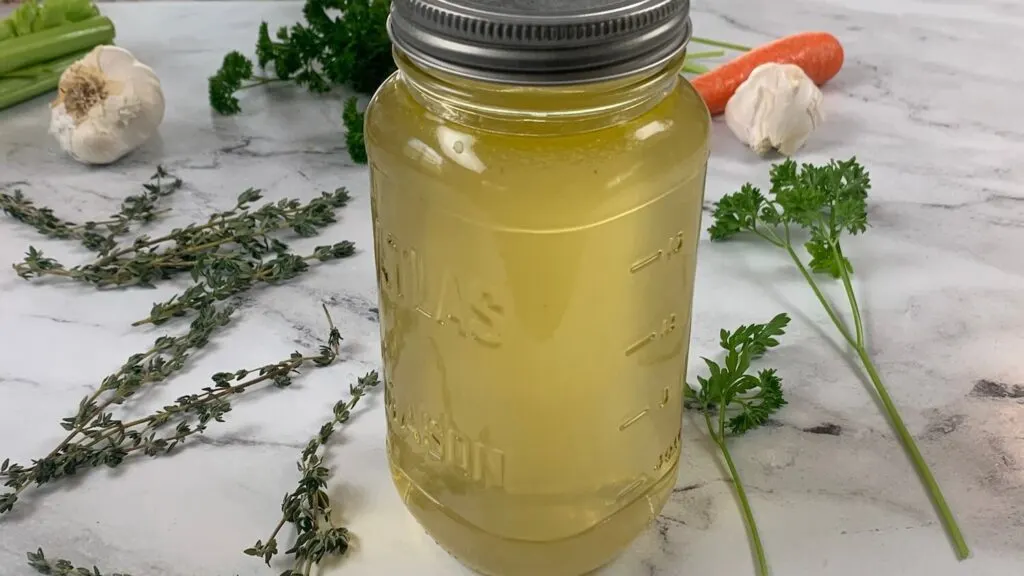
Chicken broth is prepared the same way, and often times with the same ingredients, as beef broth only using chicken instead of beef. As such, chicken broth does have a meaty flavor but does not have the richness of beef broth.
To remedy this, I would combine with Worcestershire sauce or soy sauce to give it a deeper rich flavor. If you don’t have either sauce, chicken broth does work as a good substitute on its own.
Like beef broth, the ingredients are naturally gluten-free but be sure to check your labels as there may be wheat in some of the spices. Since this contains chicken, this is not a vegetarian or vegan friendly option.
11. Chicken Bouillon Cubes
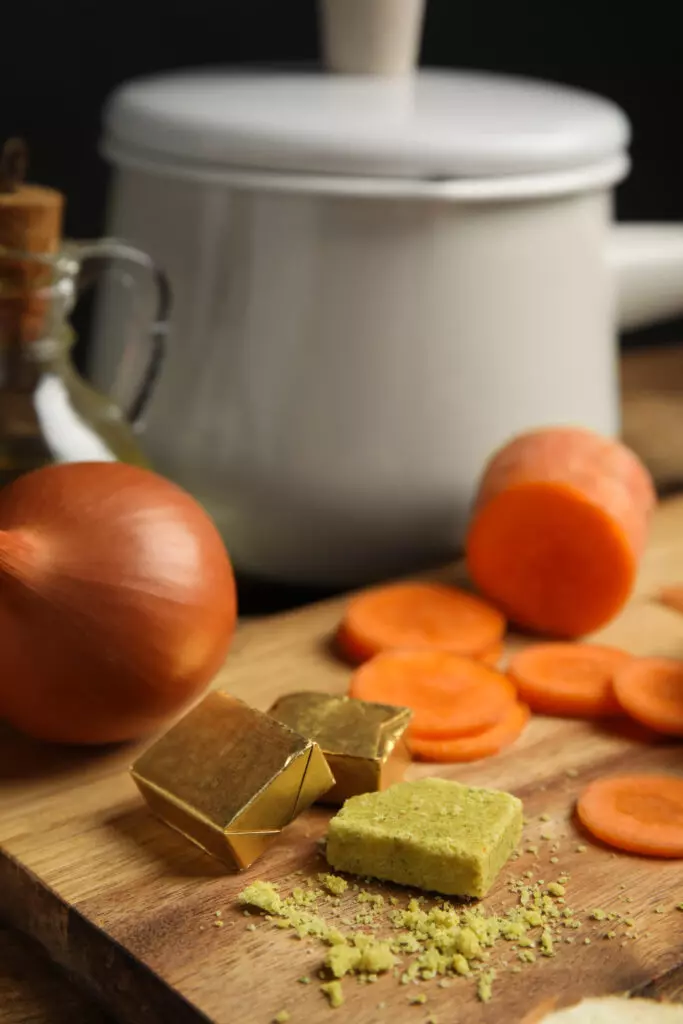
Chicken bouillon cubes are dehydrated chicken broth and can be a great substitute once dissolved in boiling water. Like chicken broth, I would encourage you to add Worcestershire sauce or soy sauce if you have it. This will help to give it a deeper flavor and color.
Be sure to read the labels if you are looking for gluten-free bouillon cubes as many do contain wheat. This is not a vegetarian or vegan friendly option as it contains chicken.
12. Liquid Aminos
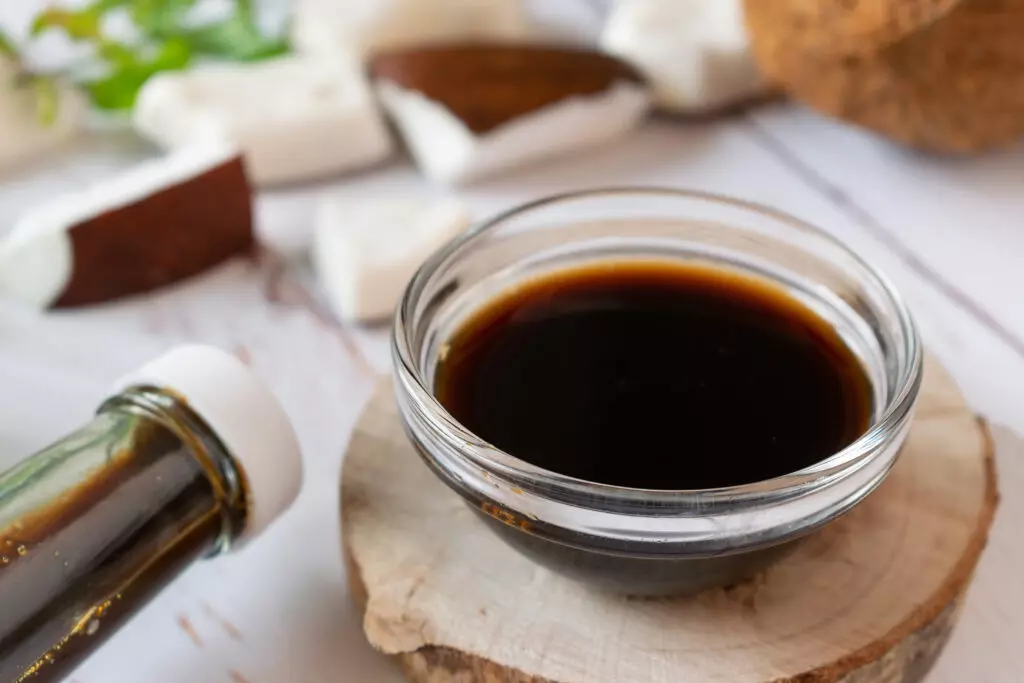
Liquid aminos is a often used as a substitute for soy sauce. It can be used just as you would soy sauce, including adding to water or vegetable broth as a substitute for beef broth. This is often used by celiacs as a gluten-free option to soy sauce.
Although it’s not as salty as soy sauce, it still has a salt flavor that will work well in moderation but can be overpowering if you use too much. As such, I would mix a half of a cup of liquid aminos with a half a cup of water. Or if you are mixing into another broth to give it some depth, I would mix a fourth a cup of aminos with three fourths of a cup of broth. You can then substitute the liquid aminos mix on a 1:1 ratio.
Liquid aminos are naturally vegetarian, vegan, and gluten-free.
13. Tomato Paste
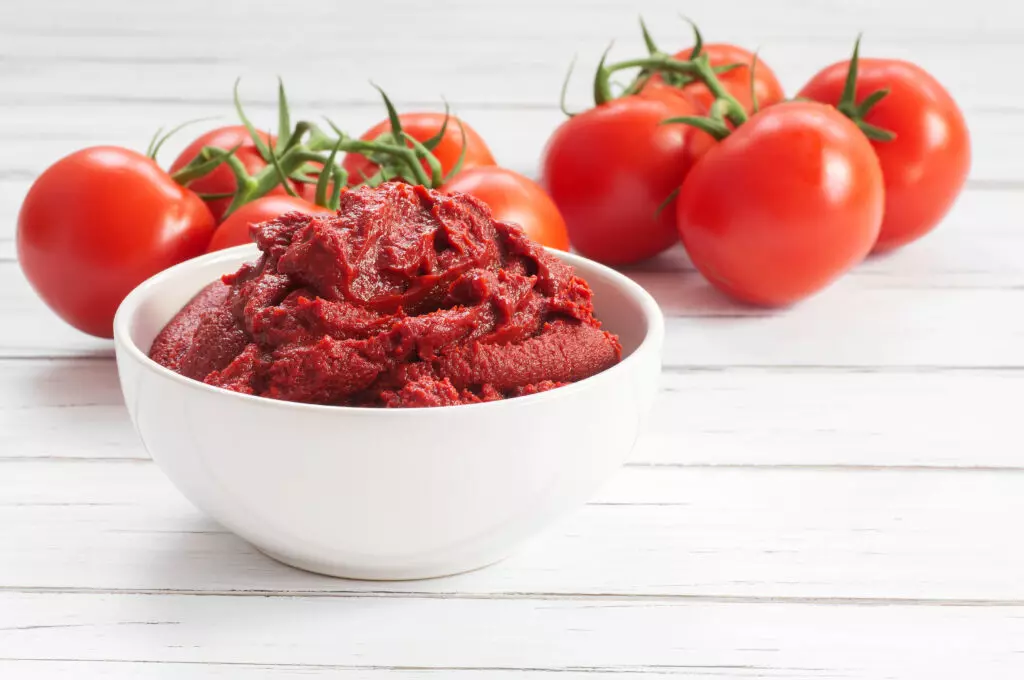
Tomato paste adds a rich and deep flavor which makes it a good substitute for beef broth. However, if available, I would combine with soy sauce, aminos or Worcester sauce to add salt and a wider depth of flavor. If you only have tomato paste that will work fine by itself as well.
To substitute, I would mix one tablespoon of tomato paste and one tablespoon of soy, Worcester or aminos, if available, with one cup of warm water and dissolve. You can then substitute on a 1:1 ratio.
This is a gluten free and vegan friendly option.
14. Dashi

Dashi is a type of stock commonly used in Japan that is typically made from dried kelp (kombu) and dried bonito or skipjack flakes (katsuobushi). It has a savory and salty flavor that make it a suitable substitute for beef broth.
You can substitute one cup of dashi for one cup of stock.
Dashi is naturally gluten-free but, as always, read the labels to confirm that no additive contains gluten. Since Dashi uses fish flakes in many of it’s recipes, it is not typically a vegetarian or vegan option. However, it can be made vegetarian and vegan.
Check out the following article for more information on dashi and a quick and easy recipe and video: How to Make Authentic Japanese Dashi
15. Beer

While not always at the top of people’s minds, beer make a great substitute for beef broth. Dark, full bodied beer works best but lighter beers will also work in a pinch.
While I love drinking beer, this is probably my least favorite substitute because I don’t think it matches the flavor of beef broth as well. However, this does work in a pinch.
I would reduce the beer by half before substituting. This will give you a more pronounced flavor and will cook down the alcohol. You can then substitute the reduced beer with beef broth using a 1:1 ratio.
While beer typically contains gluten, gluten-free beer would work just as well and be a good gluten-friendly alternative. This is also a good vegetarian and vegan option.
Bonus: Make Your Own Beef Broth
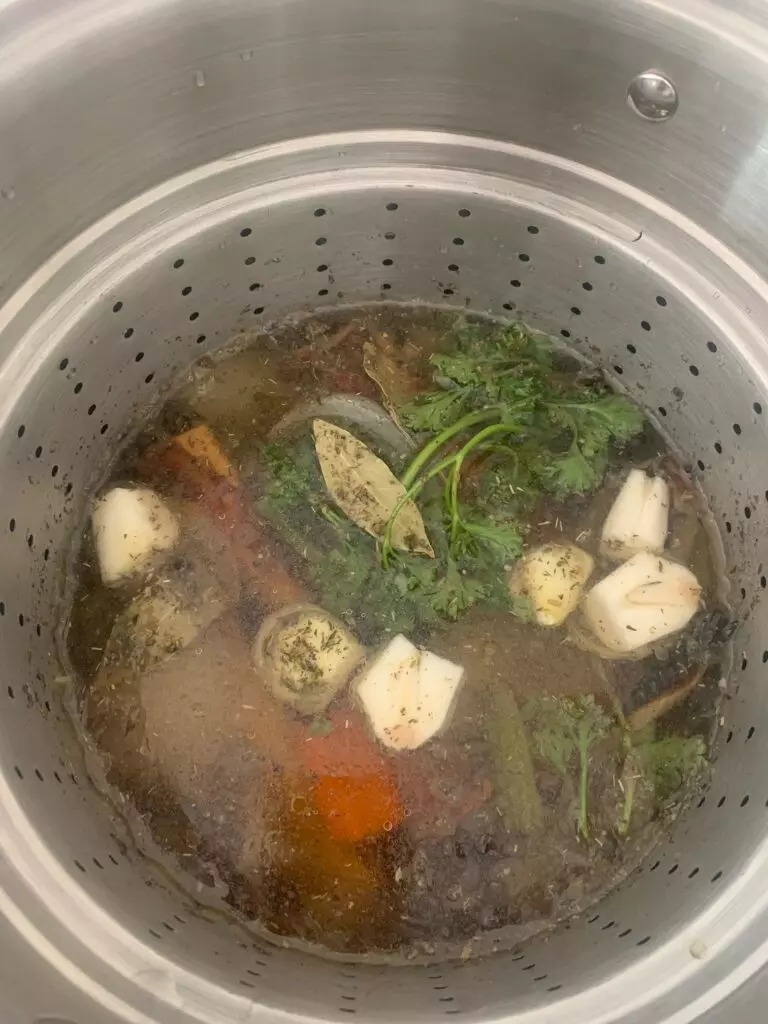
Another option if you don’t have beef broth is to make your own. Granted, this does require ingredients and takes some time so it may not be the most convenient option. However, if you have the time, I think this is the best option of them all. No matter the brand, I always prefer my own beef broth to store bought broth as mine always seems to have a richer flavor.
Making your own broth is easy, though a little time consuming. I prefer to use soup bones with beef on them instead of the beef by itself as the bones add a deeper and richer flavor. I roast the bones and vegetables prior to combining with the water and aromatics as it also gives it a deeper flavor. After combining the bones, vegetables, aromatics, and water, you simmer anywhere from 3 to 12 hours. Since I use bones with the beef, I like to simmer as long as I can. The longer it simmers, the deeper the flavor. I also add tomato paste with the aromatics as I think this adds to the depth of the flavor. After the broth is done simmering, strain all the solid components out and you have your broth.
If you need to freeze your beef broth, check out the following article: How Long Does Beef Broth Last in the Fridge? All Your Questions Answered
I like this option as you can tailor your recipe to your taste preferences. I encourage you to experiment with different batches to learn the subtleties of using different ingredient combinations and preparation methods. I included my favorite beef broth recipe below:
Beef Broth Recipe
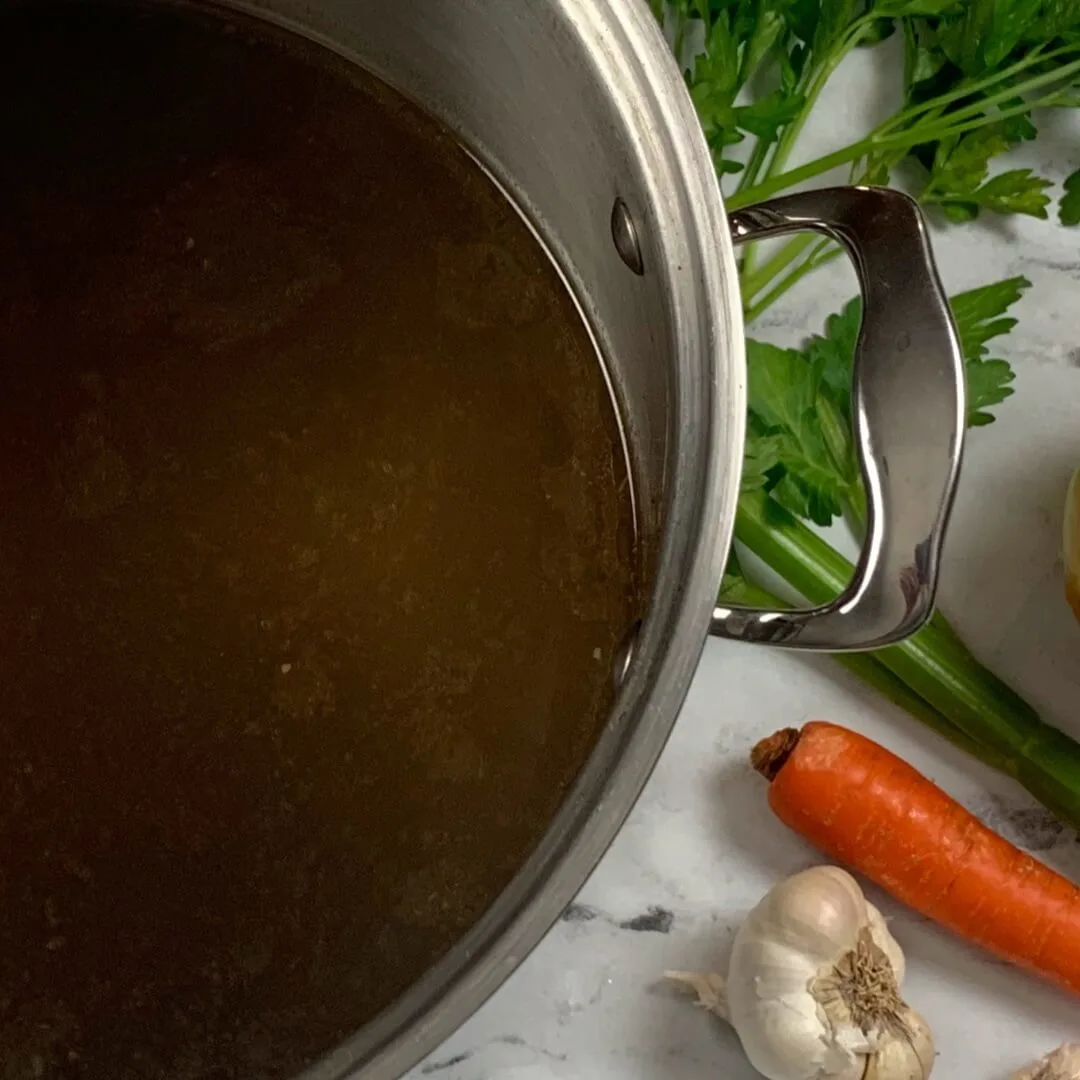
Beef Broth Recipe
Equipment
- 1 Large pot
- 1 Roasting pan
Ingredients
- 3 to 4 Pounds Meaty Beef Soup Bones
- 2 Onions Quartered
- 4 Ribs Celery Cut into 3" pieces
- 4 Carrots Cut into 3" pieces
- 1 tsp Dried Oregano
- 1 tsp Whole peppercorns
- 4 Cloves Fresh Garlic
- 4 Bay Leaves
- 5 Sprigs of Fresh Parsley
- 1 tsp Dried Thyme
- 1/2 tsp Salt
- 1/4 tsp Paprika
- 1 cup Warm water
- Cold Water
Instructions
- Preheat oven to 450 degrees and arrange the soup bones into a roasting dish
- Remove the ends from the carrots and celery and cut the veggies into 3" (7.5 cm) pieces. Remove the skin from the onion and cut into fourths. Then add all cut veggies to a baking sheet.
- Roast soup bones for 60 minutes uncovered. After 30 minutes, add the veggies to the oven and roast the vegetables for the remaining 30 minutes uncovered.
- Once done roasting, transfer the bones and vegetables to a large pot. I like to use a large pasta pot with a built in strainer. This makes it easier to strain the broth when it's done simmering. I would use tongs or a slotted spoon to transfer the bones and vegetables first, then pour in the remaining liquids from the bottom of the roasting pan and baking sheet.
- Use the cup of warm water and a plastic spatula to scrape the beef bits off the bottom of the roasting pan and add to the pot with the bones and veggies. This adds a rich, beefy flavor to the broth.
- Fill the pot with just enough cold water to cover the bones and veggies and add the remaining seasonings. Once the water and seasonings are added, give the pot a good stir to mix everything together.
- Uncovered, bring the water to a boil then reduce the heat to simmer for 4 to 5 hours. Make sure the ingredients are covered when it starts to simmer. Add water if necessary in the beginning.
- Once done simmering, remove the pot from the heat and strain the broth. If you have a pot with a fitted strainer, this is as easy as lifting the strainer out of the pot. However, be sure to do so slowly to avoid splashing the hot broth onto yourself. If you don't have a strainer already in your pot, you can place a strainer over a new pot and strain the broth into this new pot. Discard all the bones and veggies.Note: If you use a pot with a built in strainer, I usually strain again with a finer strainer to get the random peppercorns and other small bits.
- Transfer broth into a large bowl or two, cover, and chill in the fridge. Once chilled, skim the fat off the top of the broth before using.
- Beef broth will be good covered in the fridge for up to 3 days or frozen for up to 6 months. Enjoy!
Video
Nutrition
Frequently Asked Questions
What is the difference between beef stock and beef consommé?
Beef consommé is beef stock that has been clarified, meaning having all the particles removed, and reduced by half, giving the final product a clear appearance and a more intense flavor. Beef stock is also intended to be an ingredient where beef consommé is intended to be eaten as a soup.
What is the difference between beef broth and beef stock?
Beef broth is made by combining beef meat, sometimes on the bones and sometimes by itself, with mirepoix vegetables and aromatics, and simmering in water for a number of hours before straining the solid contents out. Beef stock is prepared the same way except it uses cleaned beef bones instead of beef. Beef broth often contains more seasoning where beef stock is typically just the beef bones, mirepoix and aromatics simmered and strained.
What is the difference between beef stock and beef bone broth?
Beef bone broth and beef stock generally use the same ingredients and are both simmered in water for long periods of time. However, bone broth typically uses bones with lots of connective tissues that make it rich in collagen where beef stock can use any type of beef bones. Bone broth is typically simmered for longer periods of times, often up to two days, where beef stock generally simmers for less time.
What is the difference between beef stock and beef base?
Beef base is beef stock that has been reduced by half. The ending result is a liquid that is thicker than beef stock and has a darker color and more concentrated flavor. Beef base is often used as an ingredient in recipes that require a deep beef flavor with less liquid than a beef stock or broth.
Final Thoughts on Beef Broth Substitutes
Different options work better for different recipes, so definitely take the intended use into consideration when choosing the best alternative. Whatever your reason for seeking out a beef broth substitute, I hope you find a great alternative in one of the above options. Happy cooking!
For more great substitute ideas check out the following articles:
8 Best Kashmiri Chili Powder Substitutes
Top 10 Substitutes for Jalapeño Peppers
Also, subscribe to our YouTube Channel for some great videos!
